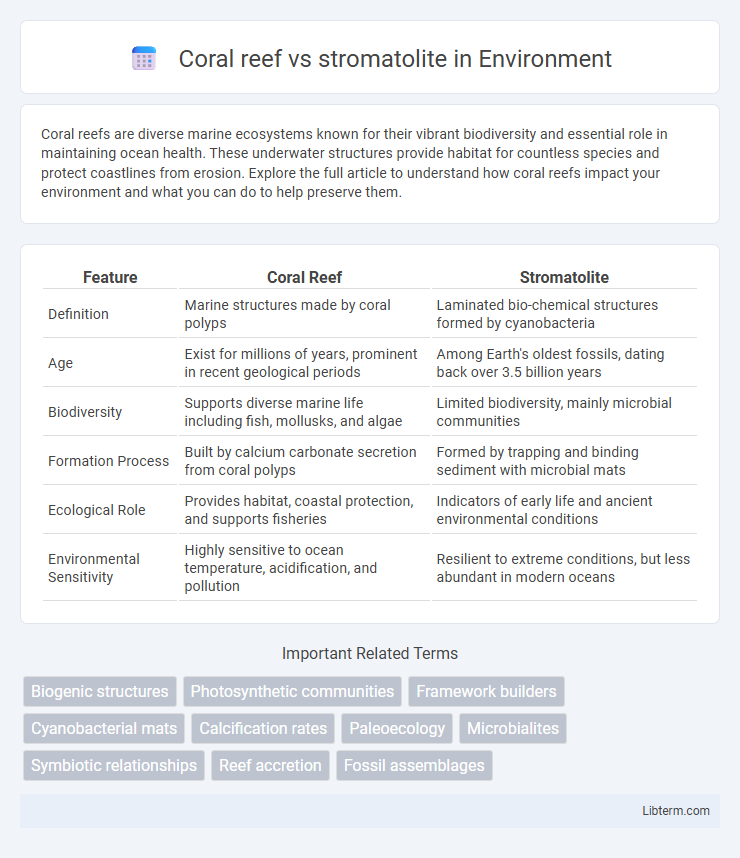Coral reefs are diverse marine ecosystems known for their vibrant biodiversity and essential role in maintaining ocean health. These underwater structures provide habitat for countless species and protect coastlines from erosion. Explore the full article to understand how coral reefs impact your environment and what you can do to help preserve them.
Table of Comparison
| Feature | Coral Reef | Stromatolite |
|---|---|---|
| Definition | Marine structures made by coral polyps | Laminated bio-chemical structures formed by cyanobacteria |
| Age | Exist for millions of years, prominent in recent geological periods | Among Earth's oldest fossils, dating back over 3.5 billion years |
| Biodiversity | Supports diverse marine life including fish, mollusks, and algae | Limited biodiversity, mainly microbial communities |
| Formation Process | Built by calcium carbonate secretion from coral polyps | Formed by trapping and binding sediment with microbial mats |
| Ecological Role | Provides habitat, coastal protection, and supports fisheries | Indicators of early life and ancient environmental conditions |
| Environmental Sensitivity | Highly sensitive to ocean temperature, acidification, and pollution | Resilient to extreme conditions, but less abundant in modern oceans |
Introduction: Comparing Coral Reefs and Stromatolites
Coral reefs and stromatolites represent two distinct marine ecosystems that highlight the evolution of ocean life from ancient to modern times. Coral reefs, formed by calcium carbonate skeletons of living corals, support diverse marine species and contribute significantly to coastal protection. Stromatolites, created by layered microbial mats primarily cyanobacteria, serve as some of the earliest evidence of life, dating back over 3.5 billion years, providing insight into Earth's primordial biosphere.
Geological Origins of Coral Reefs and Stromatolites
Coral reefs originated primarily during the Paleozoic era, formed by calcium carbonate skeletons of marine invertebrates like corals, which evolved in warm, shallow ocean waters. Stromatolites, dating back over 3.5 billion years to the Archean Eon, are layered structures created by the sediment-trapping activity of cyanobacteria, representing some of the earliest evidence of life on Earth. The geological significance of coral reefs lies in their complex biogenic limestone formations, whereas stromatolites provide crucial records of early microbial ecosystems and atmospheric oxygenation.
Biological Composition: Corals vs Cyanobacteria
Coral reefs are primarily composed of coral polyps, which are tiny marine animals belonging to the phylum Cnidaria, that form calcium carbonate skeletons creating complex three-dimensional structures. Stromatolites consist mainly of layers of cyanobacteria, photosynthetic microorganisms that trap and bind sediment to form laminated carbonate structures over geological timescales. The biological composition distinction is significant: corals contribute to reef growth through animal metabolic processes, whereas stromatolites result from microbial activity and sedimentation.
Structural Differences and Formation Processes
Coral reefs consist of calcium carbonate skeletons built by living corals through biological secretion, forming diverse, three-dimensional frameworks that support marine ecosystems. Stromatolites develop from layered sediment trapping and binding by cyanobacteria, creating laminated structures primarily through microbial activity over geological timescales. Unlike rapidly growing coral reefs, stromatolites form slowly and are among the oldest known fossil evidence of life.
Ecological Roles in Marine Ecosystems
Coral reefs provide critical habitats supporting over 25% of marine species, offering shelter, breeding grounds, and feeding areas that sustain high biodiversity and complex food webs. Stromatolites, formed by cyanobacterial mats, contribute to primary production and oxygenation in shallow marine environments, playing a foundational role in nutrient cycling and early ecosystem development. Both structures enhance marine ecosystem stability, with coral reefs supporting diverse fauna and stromatolites maintaining microbial diversity and biogeochemical processes.
Fossil Records and Evolutionary Significance
Coral reefs, primarily formed by scleractinian corals since the Triassic period, provide extensive fossil records crucial for understanding Mesozoic and Cenozoic marine biodiversity and reef ecosystem evolution. Stromatolites, dating back over 3.5 billion years, represent some of the oldest evidence of life, showcasing ancient microbial communities that contributed to oxygenating the Earth's atmosphere during the Precambrian. The evolutionary significance of coral reefs lies in their role as biodiversity hotspots supporting complex marine life, while stromatolites are key to studying early life forms and the planet's initial biospheric conditions.
Environmental Conditions for Growth
Coral reefs thrive in warm, shallow, and clear marine waters with stable temperatures ranging from 23degC to 29degC and require strong sunlight for photosynthetic symbionts like zooxanthellae. Stromatolites form in a broader range of aquatic environments, including hypersaline, high-alkalinity, and low-oxygen conditions, where cyanobacteria precipitate carbonate minerals under intense sunlight but tolerate harsher and more variable environments than corals. The ecological niches highlight coral reefs' dependence on specific tropical conditions, whereas stromatolites demonstrate resilience in extreme and fluctuating habitats.
Threats and Conservation Status
Coral reefs face severe threats from climate change, ocean acidification, pollution, and overfishing, leading to widespread coral bleaching and habitat degradation, with many reef systems classified as vulnerable or endangered by the IUCN. Stromatolites, though more resilient to environmental changes, are threatened by coastal development, sedimentation, and water quality decline, with their conservation status less studied but recognized as critical for preserving microbial diversity and Earth's early life record. Effective conservation strategies for coral reefs include marine protected areas and restoration programs, while stromatolites require habitat protection and pollution control to sustain their fragile ecosystems.
Importance to Scientific Research
Coral reefs provide critical insights into marine biodiversity, climate change impacts, and ecosystem health, serving as modern analogs for environmental studies. Stromatolites, as some of the oldest known fossils, offer invaluable data on early Earth conditions, microbial life, and the evolution of atmospheric oxygen. Together, these structures enhance understanding of both ancient and contemporary ecological processes, aiding scientific research in geology, biology, and environmental science.
Future Prospects and Human Impacts
Coral reefs face significant threats from climate change, ocean acidification, and pollution, jeopardizing their biodiversity and ecological functions. Stromatolites, ancient microbial structures, show resilience to extreme environmental changes, offering insights into ecosystem adaptation and early life on Earth. Conservation efforts and sustainable practices are crucial to preserving coral reefs, while research on stromatolites could inform biotechnological applications and environmental monitoring.
Coral reef Infographic

 libterm.com
libterm.com